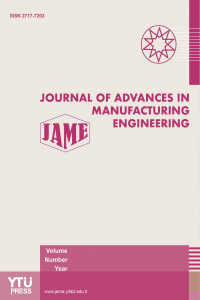Influence Structures of The Machine Tools on Roughness in Turning
Influence Structures of The Machine Tools on Roughness in Turning
Turning Roughness, Rigidity, Machine Tools, Damping,
___
- [1] Olgac, N., & Hosek, M. (1998). A new perpective and analysis for regenerative machine tools chatter. International journal of machines tools and manufacture, 38(7), 783-798.
- [2] Liang, S.Y., Hecker, R.L. & Landers, R.G. (2004). Machining process monitoring and control: the state of art. Journal manufacturing science and engineering, 126(2), 297-310.
- [3] Mahdavinegad, R. (2005). Finite element analysis of machine and work piece instability in turning. International journal of machine tools and manufacture, 45(7-8), 753-760.
- [4] Kribes, N., Ouelaa, N., Yallese, M.A. & Belhadi, S. (2007). Impact of cutting parameters and vibrations on surface roughness based on the linear multiple regression. Matériaux & Techniques, 95,197-203.
- [5] Kunpeng, Z., Wong, Y. S., & Hong, G.S. (2009). Wavelet analysis of sensor signals for tool condition monitoring: A review and some new results, International Journal of Machine Tools & Manufacture, 49, 537–553.
- [6] Tatar, K., & Gren, P. (2008). Measurement of milling tool vibration during cutting using laser vibrometry. International Journal of Machine Tools & Manufacture, 48, 380–387.
- [7] Rizal, M., Ghania, J.A., Nuawi, M.Z., & Haron, C.H.C. (2013). The application of I-kaztm-based method for tool wear, monitoring using cutting force signal, Procedia Engineering, 68, 461–468.
- [8] Alnso, F. J., & Salgado, D.R. (2008). Analysis of the structure of vibration signal for tool wear detection, Mechanical System and Signal Proceeding, 42, 735-748.
- [9] Afolalu, S.A., Salawu, E.Y., Okokpujie, I.P., Abioye, A.A., Abioye, O.P., Udo, M.O., Adetunji, O.R., & Ikumapayi, O.M. (2017). Experimental Analysis of the Wear Properties of Carburized HSS (ASTM A600) Cutting Tool. International Journal of Applied Engineering Research, 12 (19), 8995-9003.
- [10] Okokpujie, I.P., Ajayi, O.O., Afolalu, S.A., Abioye, A.A.A., Salawu, E.Y., Udo, M.O., Okonkwo, U.C., Orodu, K.B., & Ikumapayi, O.M. (2018). Modeling and Optimization of Surface Roughness in End Milling of Aluminium Using Least Square Approximation Method and Response Surface Methodology, International Journal of Mechanical Engineering and Technology (IJMET), 9(1), 587-600.
- [11] Okokpujie, I.P., Ikumapayi, O.M., Okonkwo, U.C., Salawu, E.Y., Afolalu, S.A., Dirisu, J.O., Nwoke, O.N. & Ajayi, O.O. (2017). Experimental and Mathematical Modeling for Prediction of Tool Wear on the Machining of Aluminium 6061 Alloy by High Speed Steel Tools. Open Engineering, 7, 461-469.
- [12] Nwoke, O.N., Okokpujie, I.P., & Ekenyem, S.C. (2017). Investigation of Creep Responses of Selected Engineering Materials. Journal of Science, Engineering Development, Environment and Technology (JOSEDET), 7(1), 1-15.
- [13] Orisanmi, B.O., Afolalu, S.A., Adetunji, O.R., Salawu, E.Y., Okokpujie, I.P., Abioye, A.A., Akinyemi, A.A., & Abioye, O.P. (2017). Cost of Corrosion of Metallic Products in Federal University of Agriculture, Abeokuta. International Journal of Applied Engineering Research, 12(24), 14141-14147.
- [14] Onoroh, F., Ogbonnaya, M., & Echeta, C.B. (2018). Experimental Investigation of Cutting Parameters on a Turning Tool Flank Wear (Industrial and Production Engineering). Covenant Journal of Engineering Technology (CJET), 1(1), 55-72.
- [15] Okonkwo, U.C., Nwoke, O.N., & Okokpujie. I.P. (2018). Comparative Analysis of Chatter Vibration Frequency in CNC Turning of AISI 4340 Alloy Steel with Different Boundary Conditions. Journal of Covenant Engineering Technology (CJET), 1(1), 13- 30.
- [16] Ogedengbe, T.S., Abdulkareem, S., & Aweda, J.O. (2018). Effect of Coolant Temperature on Machining Characteristics of High Carbon Steel. Covenant Journal of Engineering Technology (CJET), 1(1) 73-86.
- [17] Wayal, V., Ambhore, N., Chinchanikar, S. & Bhokse, V. (2015). Investigation on Cutting Force and Vibration Signals in Turning: Mathematical Modeling Using Response Surface Methodology. Journal of Mechanical Engineering and Automation, 5(3B), 64-68.
- ISSN: 2717-7203
- Başlangıç: 2020
- Yayıncı: Yıldız Teknik Üniversitesi
Investigation of Chip Breaker and Its Effect in Turning Operations
Experimental, Mechanical Characterizations of Friction Welding of Steel and Aluminium Joints
Abderrazak ALLALI, Mouloud AISSANI, Nadir MESRATI, Boubaker OTHMANI, Mihoub MEDKOUR, Ishaak BOUKHADOUNI
Research of Treatment Process of Conical Holes by Diamond Honing
Influence Structures of The Machine Tools on Roughness in Turning
Nabil KRİBES, Ouelaa NOUREDINE, Yallesse Med ATHMANE, Mabrouki TAREK
Analyzing Optimum Process Parameters in Laser Cutting of EN10025-2 Steel Plate
